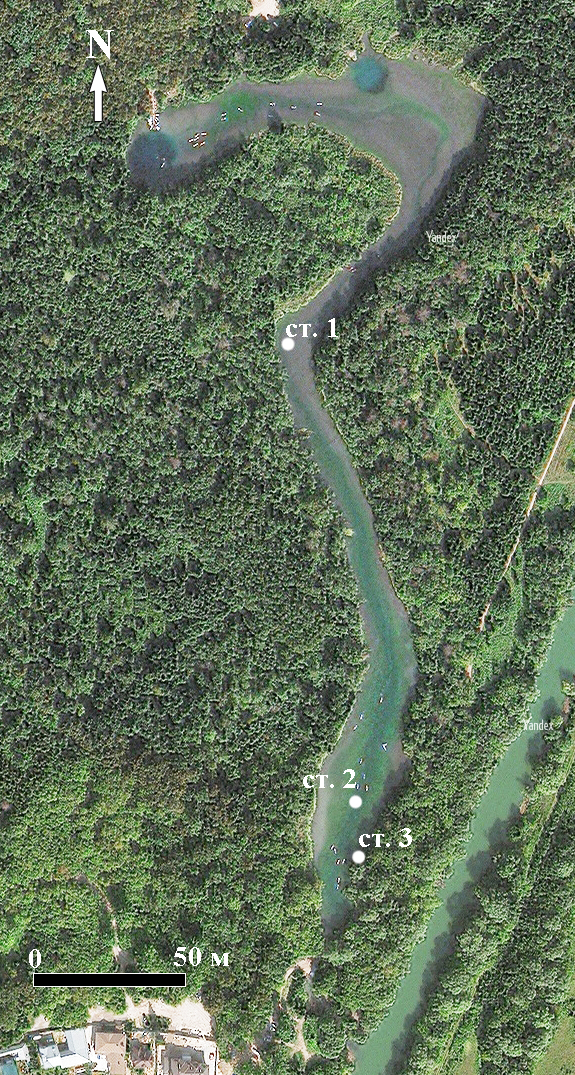Microbial communities of water and sediments of Bolshoe Goluboe Lake (the Republic of Tatarstan)
DOI:
https://doi.org/10.24852/2411-7374.2022.3.13.20Keywords:
Bolshoe Goluboe lake, bacterioplankton, bacteriobenthos, sulfur bacteria, sulfate-reducing bacteria, iron-oxidizing bacteria, oligocarbophiles, saprophytesAbstract
The microbial communities of the Lake Bolshoe Goluboe hydroecosystem (Kazan, RT) were studied. As a result of sulfate groundwater influx, microorganisms involved in the sulfur cycle develop in the lake hydroecosystem. The colorless sulfur bacteria predominate quantitatively in bacterioplankton and bacteriobenthos. The high abundance of this bacterial group indicates it important role in hydroecosystem self-purification from the hydrogen sulfide. The lake bottom sediments are inhabited by sulfate-reducing bacteria, it number increases significantly with the depth of the lake. To protect against oxidative stress, sulfate-reducing bacteria form microbial consortia with iron-oxidizing bacteria. According to microbiological indicators, the lake water is characterized as «conditionally clean». The state of the lake according to the scale of ecological modifications is estimated within the normal range.
References
Andreeva M.G., Butorova L.E., Lyubin P.A. Bakterioplankton i bakteriobentos ozera Bol'shoe Goluboe (Tatarstan) [Bacterioplankton and bacteriobentos of Bolshoe Goluboe lake (Tatarstan)] // Ustojchivoe razvitie regionov: opyt, problemy, perspektivy [Sustainable development of regions: experience, problems, prospects] / Materialy dokl. mezhdunar. konf. Kazan': AN RT, 2017a. P. 3–7.
Andreeva M.G., Butorova L.E., Tokinova R.P. Sul'fatreduciruyushchie bakterii Golubyh ozer Respubliki Tatarstan [Sulfate-reducing bacteria of the Blue Lakes of the Republic of Tatarstan] // Fundamental'nye i prikladnye nauchnye issledovaniya: aktual'nye voprosy, dostizheniya i innovacii [Fundamental and applied scientific research: current problems, achievements and innovations] / Materialy dokl. VI Mezhdunar. nauchno-prakt. konf. Penza: Nauka i Prosveshchenie, 2017b. P. 23–26.
Bryantseva I.A., Tourova T.P., Kostrikina N.A., Gorlenko V.M., Kovaleva O.L. Novaya krupnaya alkalofil'naya purpurnaya serobakteriya Ectothiorhodospira magna sp. nov. [Ectothiorhodospira magna sp. nov., a new large alkaliphilic purple sulfur bacterium] // Mikrobiologiia [Microbiology in Russian]. 2010. Vol. 79, No 6. P. 780–790.
Gridneva E.V., Grabovich M.YU., Dubinina G.A., Chernousova E.YU., Akimov V.N. Ekofiziologiya litotrofnyh serookislyayushchih predstavitelej roda Sphaerotilus – obitatelej sul'fidnyh istochnikov Severnogo Kavkaza [Ecophysiology of lithotrophic sulfur-oxidizing representatives of the genus Sphaerotilus – inhabitants of sulfide sources of the North Caucasus] // Mikrobiologiia [Microbiology]. 2009. Vol. 78, No 1. P. 89–97.
Dzuban A.N., Kosolapov D.B., Kuznecova B.B. Mikrobiologicheskie processy v donnyh otlozheniyah Rybinskogo vodohranilishcha i ozera Pleshcheevo kak faktory formirovaniya kachestva vodnoj sredy [Microbiological processes in bottom sediments of Rybinsk reservoir and Plesheevo Lake as factors in formation of the quality of aquatic environment] // Gidrobiologicheskij zhurnal [Hydobiological journal]. 2005. Vol. 41, No 4. P. 82–88.
Zaharova Yu.R., Parfenova V.V. Metod kul'tivirovaniya mikroorganizmov, okislyayushchih zhelezo i marganec v donnyh osadkah oz. Bajkal [The method of cultivation of microorganisms that oxidize iron and manganese in the bottom sediments of Baikal Lake] // Izvestiya RAN. Seriya biologicheskaya [Biology Bulletin of the Russian Academy of Sciences]. 2007. No 3. P. 290–295.
Zvyagincev D.G. Metody pochvennoj mikrobiologii i biohimii [Methods of soil microbiology and biochemistry]. Moscow: Moscow state university, 1991. 304 p.
Ivanov D.V., Ziganshin I.I., Malanin V.V., Marasov A.A., SHamaev D.E., Rupova E.H. Harakteristika donnyh otlozhenij Golubyh ozer g. Kazani [Characteristics of bottom sediments of Blue lakes of Kazan] // Rossijskij zhurnal prikladnoj ekologii [Russian Journal of Applied Ecology]. 2016. No 3. P. 19‒22.
Koleshko O.I. Ekologiya mikroorganizmov pochvy: Laboratornyj praktikum [Ecology of microorganisms of soil: Laboratory practice]. Minsk: Vysshaya shkola, 1981. 175 p.
Kuznecov S.I., Dubinina G.A. Metody izucheniya vodnyh mikroorganizmov [Methods of investigation of water microorganisms]. Moscow: Nauka, 1989. 288 p.
Morozova O.V., Tokinova R.P., Ivanov D.V. Ekologo-mikrobiologicheskaya ocenka kachestva vody ozera Komsomol'skoe v usloviyah urbanizacii [Ecological and microbiological assessment of Lake Komsomolskoye water quality under urbanization] // Trudy Karel'skogo nauchnogo centra RAN, ser. Limnologiya [Proceedings of the Karelian scientific center of the Russian Academy of Sciences, ser. Limnology]. 2021. No 4. P. 119–133. DOI: 10.17076/lim1322.
Netrusov A.I., Kotova I.B. Mikrobiologiya [Microbiology]. M.: Akademiya, 2006. 352 p.
RD 52.24.309-2016. Rukovodyashchij dokument. Organizaciya i provedenie rezhimnyh nablyudenij za zagryazneniem poverhnostnyh vod sushi [Guidance document. Organization and conduct of monitoring observations of pollution of water land.].
Tokinova R.P., Lyubarsky D.S. Flora i rastitel'nost' solonovatyh vodoemov prirodnogo zakaznika «Golubye ozera» (Srednee Povolzh'e) [Flora and vegetation of brackish reservoirs of the Nature Reserve “Golubye ozera” (Middle Volga region)] // Botanicheskii zhurnal [Botanical journal]. 2019. Vol. 104, No 10. P. 1499–1513. DOI: 10.1134/S0006813619100119.
Tokinova R.P., Berdnik S.V., Butorova L.E., Lyubarskiy D.S., Andreeva M.G., Abramova K.I., Lyubin P.A. Bioraznoobrazie Golubyh ozer Prikazan'ya [Biodiversity of the Golubye lakes of Kazan] // Rossijskij zhurnal prikladnoj ekologii [Russian journal of applied ecology]. 2017. No 4. P. 16–20.
Unikal'nye ekosistemy solonovatovodnyh karstovyh ozer Srednego Povolzh'ya [Unique ecosystems of brackish-water karst lakes of the Middle Volga region] / Red. A.F. Alimov, N.M. Mingazova. Kazan': Kazan university, 2001. 256 p.
Brooks C.N., Field E.K. Orange leads to black: evaluating the efficacy of co-culturing iron-oxidizing and sulfate-reducing bacteria to discern ecological relationships // Environmental microbiology reports. 2021. Vol. 19, No 3. P. 317–324. DOI: 10.1111/1758-2229.12932.
Lavrentyeva E.V., Banzaraktsaeva T.G., Radnagurueva A.A., Buryukhaev S.P., Dambaev V.B., Baturina O.A., Kozyreva L.P., Barkhutova D.D. Microbial community of Umkhei Thermal Lake (Baikal Rift Zone) in groundwater discharge zone // Contemporary problems of ecology. 2019. Vol. 12. P. 584–593. DOI: 10.1134/S1995425519060088.
Morozova O.V., Ratushnyak A.A., Trushin M.V. Participation of planktonic and benthic bacteria in the polyphosphate-accumulating process in mesocosms contaminated with phosphate and nitrate // World applied sciences journal. 2012. Vol. 19, No 1. P. 12–19. DOI: 10.5829/idosi.wasj.2012.19.01.64182.
Muyzer G., Kuenen J. G., Robertson L. Colorless sulfur bacteria // The Prokaryotes / Eds. E. Rosenberg, E.F. DeLong, S. Lory, E. Stackebrandt, F. Tompson. Heidelberg: Springer, 2013. P. 555–588.

Downloads
Published
Versions
- 2022-09-30 (2)
- 2022-09-30 (1)
How to Cite
Issue
Section
License

This work is licensed under a Creative Commons Attribution-NonCommercial 4.0 International License.




